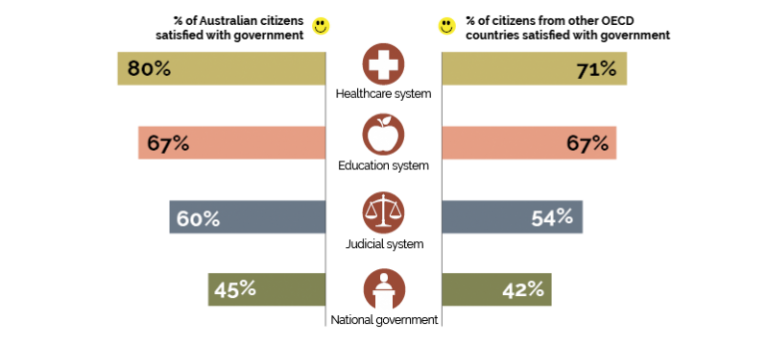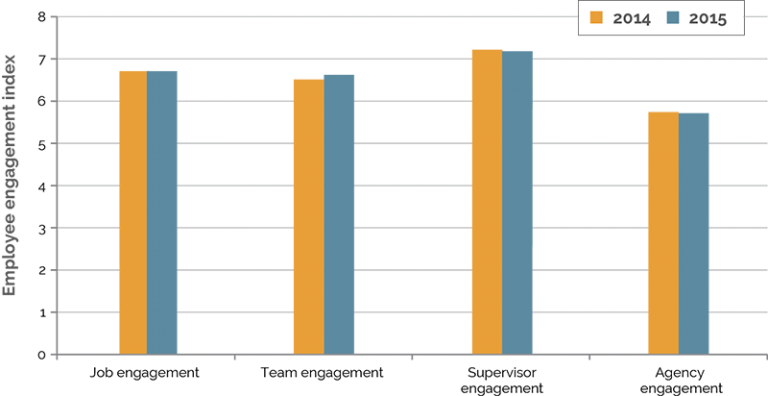Overview
Key points
- The APS has a long history supporting successive Australian Governments.
- The APS has a highly engaged workforce.
- A strong and compelling employment proposition is critical to attracting the best candidates in the Australian market.
- The recruitment of graduates continued during recent recruitment restrictions. This confirms their ongoing importance to APS renewal.
On 1 January 1901, the APS came into being with six departments—Attorney-General's, Defence, External Affairs, Home Affairs, Trade and Customs, and the Treasury. Since Federation, the APS has played an essential role in the governance of Australia. It has continued to exemplify professionalism and an apolitical and impartial commitment to service.
The Public Service Act 1999 (the Act) provides the framework for managing the APS. The Act establishes an apolitical public service. It defines the duties and powers of agency heads and provides a legal framework for the employment of APS employees. The rights and obligations of those employees are set out in the Act.
Public Service Act 1999 Part 1, Section 3
The main objects of this Act are:
- to establish an apolitical public service that is efficient and effective in serving the Government, the Parliament and the Australian public; and
- to provide a legal framework for the effective and fair employment, management and leadership of APS employees; and
- to define the powers, functions and responsibilities of Agency Heads, the Australian Public Service Commissioner and the Merit Protection Commissioner; and
- to establish rights and obligations of APS employees.
The Act's objects include that the APS exists to serve the Government, the Parliament and the people of Australia. Most Australians interact with the APS on a daily basis. From infrastructure to health care and education, the APS plays a critical role in the operation of the country.
Citizens' view of the APS
In terms of citizen satisfaction with government, Australia performs as well or better than the Organisation for Economic Cooperation and Development (OECD) average on each of the following measures
The historical contribution of the APS to Australia's development is something of renown. It has performed well. Looking ahead, there are new challenges and opportunities for Australia. The APS must continue to ensure it has the capabilities and capacities to respond to them in the most efficient and effective ways.
The challenges include issues such as tightening labour markets, an ageing population, fast-paced technological change, globalisation and the need for productivity improvements to balance the budget in the longer term.
The State of the Service report canvasses the activities and HR management practices of the APS during the 2014–15 financial year. It also charts the anticipated priorities for the service as it looks ahead.
The State of the Service reports over the years have chronicled major reforms to the APS, including in the areas of the financial framework, employment and personnel management, service delivery and program implementation. Findings from the reports have helped the APS to identify capability gaps and take informed decisions about filling them. This year's report focuses on enhancing APS workforce capability and modernising the APS employment framework. Both are critical to improving public sector performance and promoting integrity.

An engaged and committed workforce
Data from the 2015 APS employee census demonstrates that employee engagement in the APS remained high in 2014–15, particularly job engagement and engagement with immediate supervisors.
Figure 1: APS employee engagement scores, 2014 and 2015

Source: Employee census
*Data corrected post tabling of State of the Service report 2014–15
Significant variations are evident across job, team, supervisor and agency engagement measures depending on agency function. Specialist and policy agencies were consistently rated higher on each measure. Members of the Senior Executive Service (SES) also report higher engagement levels on each measure compared to the workforce overall. These and other results from the APS employee census are available on the State of the Service website.
Sixty-six per cent of APS employees agree that their job gives them a feeling of personal accomplishment and 73% report that their current work uses their skills. Eighty per cent of employees agree they have a good supervisor and 68% agree their agency is committed to creating a diverse workforce. Seventy-three per cent of employees report their workgroups are honest, open and transparent in their dealings. Seventy-two per cent are satisfied with their work-life balance and their ability to access flexible work arrangements.
Seventy-four per cent of APS employees report they are tasked appropriately for their classification, 80% are clear what their duties are and 73% report they have the appropriate decision-making authority to do their jobs. These results are particularly pleasing when considered against a backdrop of significant functional and structural reforms.
The APS employment proposition
The APS employment proposition must be clear and compelling. Our goal is to have the best and brightest people aspire to work for some or all of their careers in the APS. To this end, it is important to understand what attracts people to a public sector career and what factors cause people to leave.
The Commission since 2013 has managed an entry and exit survey to assist agencies obtain information about engagements, retention and internal staff movements. The most common reason for joining the APS was the type of work available. Most employees taking up an ongoing position expected to stay with their new agency for at least two years. Employees reported that the people they work with, the work they undertake and development opportunities are key factors that encourage them to remain in the APS.
Most respondents to the exit survey reported that they were leaving their agency voluntarily. Employees who resigned had significantly lower engagement levels than all other respondents. It is important to understand the factors that help to explain this. Employees most commonly reported that a lack of future career opportunities impacted the decision to leave their agency. A desire to try a new career, unmet work expectations or having achieved all they could in their job, were all important factors. The loss of these employees needs to be considered in terms of the value
to society of movement between sectors. It can broaden employee perspectives. Each APS vacancy also creates an opportunity for organisational renewal.
Not all employees leave their agency for work or career reasons. Those who leave for personal reasons were most likely to cite family responsibilities as important in shaping their decision. Age also plays a role, with employees aged under 35 years likely to report that their decision to leave was influenced by a wish to live elsewhere in Australia or overseas. Older employees were more likely to leave to travel or for recreation. Flexible working arrangements such as teleworking for younger employees and increased levels of part-time work for older employees may provide agencies with an opportunity to retain more of these individuals.
APS graduate recruitment
The graduate programs run by agencies represent a major investment by the APS. They are an important source of talented employees. It is hoped that many will become effective senior leaders. Significant differences exist between graduates and other new entrants to the APS in terms of what attracts them to the APS. Graduates are more likely to rate long-term career progression as more important than general entrants.
Graduates are less likely to rate the geographic location of the job as important. Many graduates move interstate to take up a position in the APS. They are more likely to rate the security and stability of the job as important, as well as their development.
Report structure
The State of the Service report draws on a range of information sources.
The traditional sources are the State of the Service agency survey, the APS employee census and the APS Employment Database (APSED). Information about the agency survey, employee census and APSED can be found on the State of the Service website2. In addition external sources are used including the Australian Human Resources Institute (AHRI) and independent senior reviewers.
The remainder of the 2014–15 State of the Service report is structured around the following themes:
- workforce capability, with a focus on leadership, diversity, talent management and attendance management
- the APS employment framework, including recruitment and employee mobility
- public sector performance, focusing on organisational capability, such as digital transformation readiness and innovation, and findings from the agency capability reviews
- APS Values and promoting integrity, including breaches of the Code of Conduct and perceptions of corruption in the APS.
2 Australian Public Service Commission 2015, State of the Service, Commonwealth of Australia, Canberra, viewed 2 October 2015.



